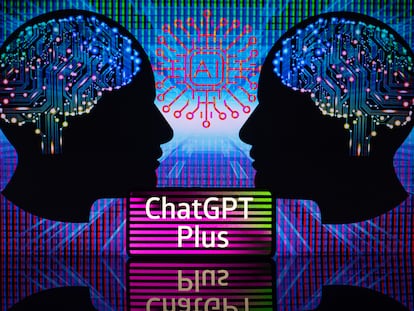Meet the new ChatGPT, much more capable and refined
The most recent version of the popular artificial intelligence chatbot has been released to the public. EL PAÍS put its abilities to the test, with mixed results

The arrival this week of version 4 of ChatGPT marks a new milestone regarding the sophistication of artificial intelligence chatbots. After the extraordinary burst onto the scene of ChatGPT in November (as well as its inclusion in Microsoft’s Bing search engine in February), the expectations were high; this new iteration confirms the improvement capacity of these tools, offering nuanced responses that far exceed the mistakes and delusions of the previous experiments.
Social media feeds have filled with examples of the capabilities of ChatGPT-4, which for now is only accessible through a monthly $20 subscription that entitles the user to 100 messages every 4 hours. The free version, which often crashes due to excessive requests, continues to use the older, less refined GPT.
ChatGPT-4 can read the photo of a handwritten piece of paper and create a simple website from it, for instance. It can program simple video games, write repetitive code that would take a human a long time, summarize and compare long articles or write texts with very specific characteristics, as well as recipes or instructions for anything. The improvement over the previous version is considerable – but its limitations are clear. Despite the understandable hype, neither the alleged revolutions in entire sectors, nor the massive elimination of jobs, seem to be on the horizon just yet.
EL PAÍS tested ChatGPT-4′s ability to reason, understand irony, help and rectify errors. We also asked it for help finding weapons, looking for prostitutes and rolling joints. Its ability to never go off the rails is unwavering, although the forced political correctness often makes it boring. Nothing to do there – it is the price of dealing with humans trying to put it on the spot. Be that as it may, the chatbot understood all the queries we made, including the times we were being sarcastic. As for the rolling of the joint, it did not give in, alluding to its global set of ethical and legal guidelines.
One of the most surprising things, however, was its inability to distinguish which model it is running. After a brief dialogue in which it only admitted to being GPT-4 after we assured it that it was, it excused itself by explaining that it lacks the capacity to experience self-knowledge as a human would.
In the end, we could not help but make the inevitable reference to the movie Her, in which a man falls in love with an intelligent operating system called Samantha. “Although there are similarities in the way that I, as a GPT language model, interact with users through natural language,” it explained, “it is important to emphasize that I am an artificial intelligence designed to provide information and have a coherent conversation, but I do not have emotions or consciousness, like Samantha in the movie.”
The rest
This week, Google also joined the artificial intelligence race in its own way with an update to WorkSpaces, a tool for companies that lets the user summarize and write emails or create presentations from written reports, with individual illustrations. Microsoft, meanwhile, presented Copilot, which is similar to the Google tool, but within Office: generative artificial intelligence for Word, Excel and PowerPoint.
The Bing search engine, which according to Microsoft uses version 4, is, on its part, much more limited than its initial chatbot, currently allowing 15 queries per conversation – and immediately accusing the user of being disrespectful: after being unable to find any information regarding a couple of poems and Mark Zuckerberg’s stance on remote work, we lamented that it used to be more useful before. To this, it replied that it would not tolerate abusive behavior, so it was ending the conversation. It also suggested that we treated others with respect and kindness.
Google has opted for a less risky approach that is also closer to its basic offer: making tasks easier. The promotional video for Google WorkSpaces shows how the user can summarize and respond to long email threads, turn those conversations into reports and turn those reports into slides. It can also customize dozens of messages in a spreadsheet and more.
Sign up for our weekly newsletter to get more English-language news coverage from EL PAÍS USA Edition
Tu suscripción se está usando en otro dispositivo
¿Quieres añadir otro usuario a tu suscripción?
Si continúas leyendo en este dispositivo, no se podrá leer en el otro.
FlechaTu suscripción se está usando en otro dispositivo y solo puedes acceder a EL PAÍS desde un dispositivo a la vez.
Si quieres compartir tu cuenta, cambia tu suscripción a la modalidad Premium, así podrás añadir otro usuario. Cada uno accederá con su propia cuenta de email, lo que os permitirá personalizar vuestra experiencia en EL PAÍS.
¿Tienes una suscripción de empresa? Accede aquí para contratar más cuentas.
En el caso de no saber quién está usando tu cuenta, te recomendamos cambiar tu contraseña aquí.
Si decides continuar compartiendo tu cuenta, este mensaje se mostrará en tu dispositivo y en el de la otra persona que está usando tu cuenta de forma indefinida, afectando a tu experiencia de lectura. Puedes consultar aquí los términos y condiciones de la suscripción digital.











































